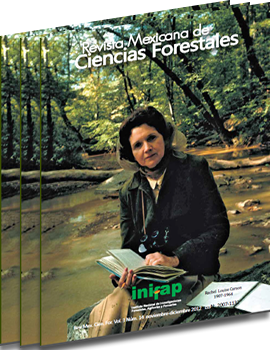FRAGMENTS SIZE IN THE PINE-OAK FOREST, SIERRA DE QUILA, JALISCO STATE
DOI:
https://doi.org/10.29298/rmcf.v3i14.472Keywords:
Ordination analysis, trees association, Pinus-Quercus forest, diversity, structure, fragmentsAbstract
Species richness, composition and abundance of tree species were assessed in relation to the size of fragments in the pine-oak forest of the protected natural area of Sierra de Quila. Two kinds of fragments were selected (10-50 hectares and >50 hectares) in open (canopy cover >40%) and closed canopy (<40%). forest. Tree inventory (DBH ≥ 7 cm) in 76 concentric sampling plots (0.05 ha) was made in a systematic sampling net. In the open forest were recorded from 1 to 17 species and in the closed forest from 16 to 24 species. Even though the difference of species richness was not significant (p>0.06) between types of cover and fragment size, there is more evenness in abundance in the open forest. Six outstanding species, Alnus acuminata, Clethra hartwegii, Pinus herrerae, Quercus candicans, Quercus excelsa and Tilia mexicana were not found in any condition <50 hectares. By ordination techniques it was found that in both fragment sizes, altitude, soil type and broad-leaf abundance significantly correlated with tree species associations. Hill side and pine abundance were relevant in open forest, while average diameter and tree density correlated with closed forest. Distribution patterns are crucial elements for integral landscape conservation and of the different conditions in which forest covers develop.
Downloads
Downloads
Published
How to Cite
Issue
Section
License
The authors who publish in Revista Mexicana de Ciencias Forestales accept the following conditions:
In accordance with copyright laws, Revista Mexicana de Ciencias Forestales recognizes and respects the authors’ moral right and ownership of property rights which will be transferred to the journal for dissemination in open access.
All the texts published by Revista Mexicana de Ciencias Forestales –with no exception– are distributed under a Creative Commons License Attribution-NonCommercial 4.0 International (CC BY-NC 4.0), which allows third parties to use the publication as long as the work’s authorship and its first publication in this journal are mentioned
The author(s) can enter into independent and additional contractual agreements for the nonexclusive distribution of the version of the article published in Revista Mexicana de Ciencias Forestales (for example, include it into an institutional repository or publish it in a book) as long as it is clearly and explicitly indicated that the work was published for the first time in Revista Mexicana de Ciencias Forestales.
For all the above, the authors shall send the form of Letter-transfer of Property Rights for the first publication duly filled in and signed by the author(s). This form must be sent as a PDF file to: ciencia.forestal2@inifap.gob.mx
This work is licensed under a Creative Commons Attribution-Noncommercial 4.0 International license.






